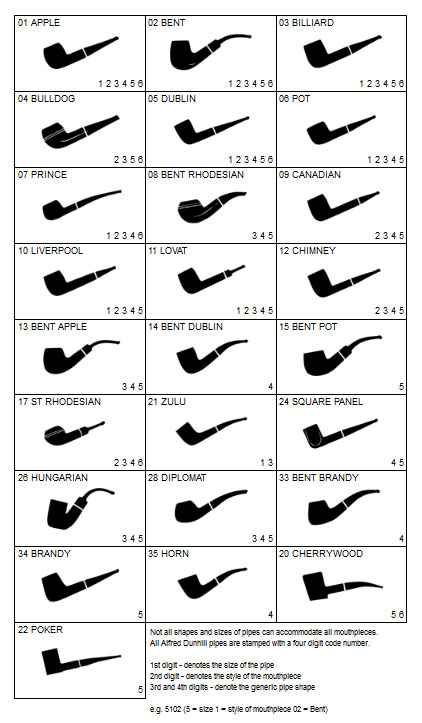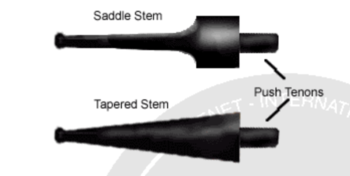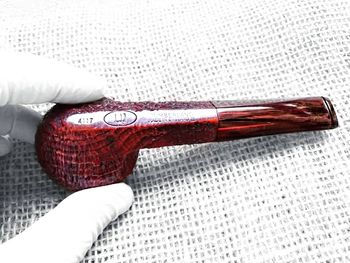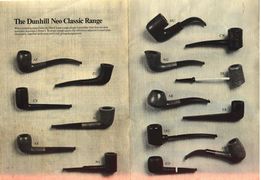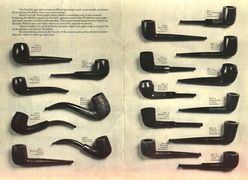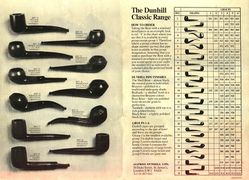Dunhill Shape Chart
Currently 25 shapes classified with 2-digit numbers.
Occasionally a piece of briar is just asking to be carved into a shape which is not in the standard list. The general term for such pipe shapes is “Quaint”.
| Digit 1: Size of the pipe - the group, 1 to 6. |
| Digit 2: Style of the mouthpiece - 1= tapered, 2= saddle. |
| Digit 3 and 4: Generic pipe shape. |
| Example: 4117 | (4: Group; 1:tappered stem; 17: Shape: Straight Rhodesian* - Dunhill criteria. |
Although scarcity of fine briar has always necessitated the pricing of Dunhill according to the amount of root employed in their manufacture, it is important to remember that, irrespective of size and price, they are of one quality only – the finest. The bowls are sorted into 6 groups.
| Group 1 / Small | Group 2 / Medium | Group 3 / Medium |
| Group 4 / Medium to Large | Group 5 / Large | Group 6 / Extra large |
The encircled group number indicates the size of the bowl (1, for example, is the smaller bowl). It is usually followed by a letter corresponding to the pipe finish. This number/letter code has been introduced about 1952 and was discontinued about 1976 replaced by a 4 or 5 digits code.

|

|

|

|

|

|
The original skus/model numbers from the 1920’s until the early 1970’s stood for very specific shapes and bowls. For example, the codes 31, 34, 59, 111, 113, 117, 196, LB, LBS... were all different types of Billiard shaped pipes and there were about 50(!), such codes for the Billiard shape alone.
The first image with the shape number 577 falls into this system, so 577 has no special meaning apart from describing / being the model for that particular pipe shape (in this case a specific group 2 Billiard with saddle mouthpiece). Around 1973, with the introduction of computers, new categories were introduced that indicated size, mouthpiece, and shape. As for the “T”, in 1952 a full-size “T” was added after the circled group size stamp to further describe the Tanshell finish (in 1953 the “T” was reduced to about half the size). So this pipe dates from 1952.
A 3-digit system (“Interim”) was developed that showed a logical approach to identify pipes in terms of size, mouthpiece, and shape, with the 1st digit being the size, the 2nd digit the mouthpiece, and the 3rd digit the shape, i.e. the old “85” became a “321” which was a group 3 Apple with taper mouthpiece. This was soon to be replaced by a more detailed, formal 4- and 5-digit system around 1978. The 5th digit indicated the style of bowl within the group of a similar classification, each identified by a last digit, which could be any number between 1-9.
Some sources such as the Pipephil portal, indicate this change in markings occurred in mid-1976, others indicate in was 1974. Either way, we offer the information that comes from an official source as follows in a 4 digit example:
While e.g. within the Gp.4 Billiard there were 5 different styles of bowls (5th digit being either 1,2,3,4, or 9), for a Gp.1 Billiard there were only 3 styles used (5th digit being 1, 2, or 9).
Although the 5-digit code was stamped on the pipe and thus was visible to the consumer, it was mostly used for internal production planning purposes and to a lesser extent for retail staff. The system proved to be quite complex.
The elimination of the 5th digit on the pipes (probably in the early 80’s) resulted in better management of the pipe stock as there were less skus and it also facilitated the work for the sales staff in the retail shops as the complexity and number of skus was considerably reduced.
The current system with 4 digits visible has now been in place for over 30 years, and has proven to work very well for Dunhill, the trade, and for consumers. Dunhill Shapes List offers a list of the principals shapes.
- When 5 digits occur, the meaning of the 4 first remain the same.
